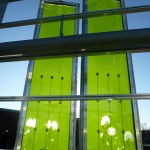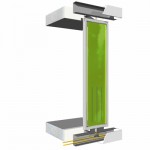Bioreactive façade with photobioreactors for cultivating microalgae as an energy resource
Text: Jan Wurm / Project: Arup
Photovoltaics (PV) and solar thermal collectors are at present the established technologies for producing energy at the building. PV currently only covers 2% of total energy consumption (Germany 2010) and a fraction is generated through Building Integrated Photovoltaics (BIPV). Biomass is by far the biggest renewable energy source; however to date no technology has been available to use this resource on the building scale.
Prototype. Photo: SSC
Participating in an international design competition Arup’s Materials Consulting and Building Physics Team in Berlin developed a façade system for integrating flat panel Photobioreactors (PBR) as external shading devices. PBR are transparent containers to facilitate photosynthesis in a controlled environment. Fast-growing species such as microalgae circulate with water and nutrition through the panels, absorbing light and carbon and producing biomass and solar thermal heat. The PBR are linked in a closed loop to the plant room where they are fed with carbon from combustion processes in the neighbourhood. The algae is harvested and transformed into methane on or off site. The generated heat is taken out of the system by heat exchangers and either stored geothermally or a heat pump instantly feeds it back into the building for heating and hot-water supply.
Key innovations
For the first time this project has identified the potentials and qualified the benefits for implementing PBR on the building skin, including the following innovations:
> Generation of biomass as a renewable energy resource in the urban context – the calculated net energy gain is approx. 30kWh per square metre and year
> Additional generation of solar thermal heat of around a further 30kWh per square metre and year
> Absorption of carbon directly at the source of domestic or industrial agents for emissions
> Self-adaptive shading device
> Dynamic architectural expression
The key innovation is the development of a multi-functional façade component and its full integration into the energy concept and the services design of an energy efficient building.
Impact
Since winning the design competition in 2010 a strong dynamics has unfolded. Arup funding served to found an industry consortium for developing the system, involving COLT as a global player for façade components and hydrobiology specialist company SSC. Arup’s Intellectual Property was secured by filing a joint international patent application. The German Federal Government provided over 300,000 € of funding. The consortium presented a prototype design at leading building trade fair BAU in Munich early 2011. On the basis of the developed design, the International Building Exhibition (IBA) in Hamburg granted a further 600,000 € for the construction of a pilot project featuring 200m² PBR including all technical components for a closed system on site. Private investor Otto Wulff was awarded with a contract to implement the technology on a 4-storey residential building in Hamburg Wilhelmsburg in 2013. This is the first application of integrated PBR in the world.
Long-term benefits of the research
The research has proven the technical feasibility of the system. The pilot project in Hamburg is a great opportunity to demonstrate its economical benefits: next to production of biomass and absorption of carbon it generates solar thermal heat and replaces mechanical shading devices. As the system allows storing solar heat in from of biomass without loss and absorbs carbon it can be a key complementary system to PV for future zero-energy and zero-carbon buildings.
Credits & info:
Client: Federal Ministry of Transport, Building and Urban Development, Germany
Collaborators: COLT International, Strategic Science Consult (SSC)
Scope of work : Façade Engineering, Materials Consulting, Building Physics, Research Management
Investment: 43.200 £
Author: Jan Wurm




